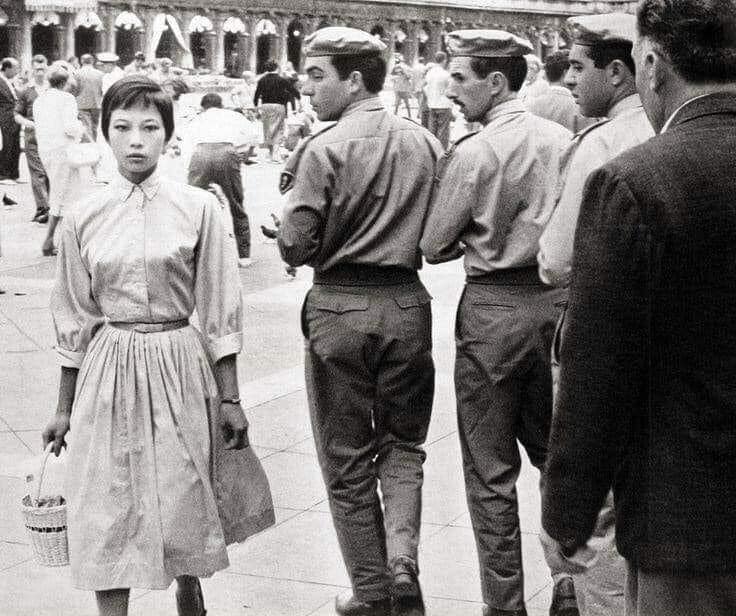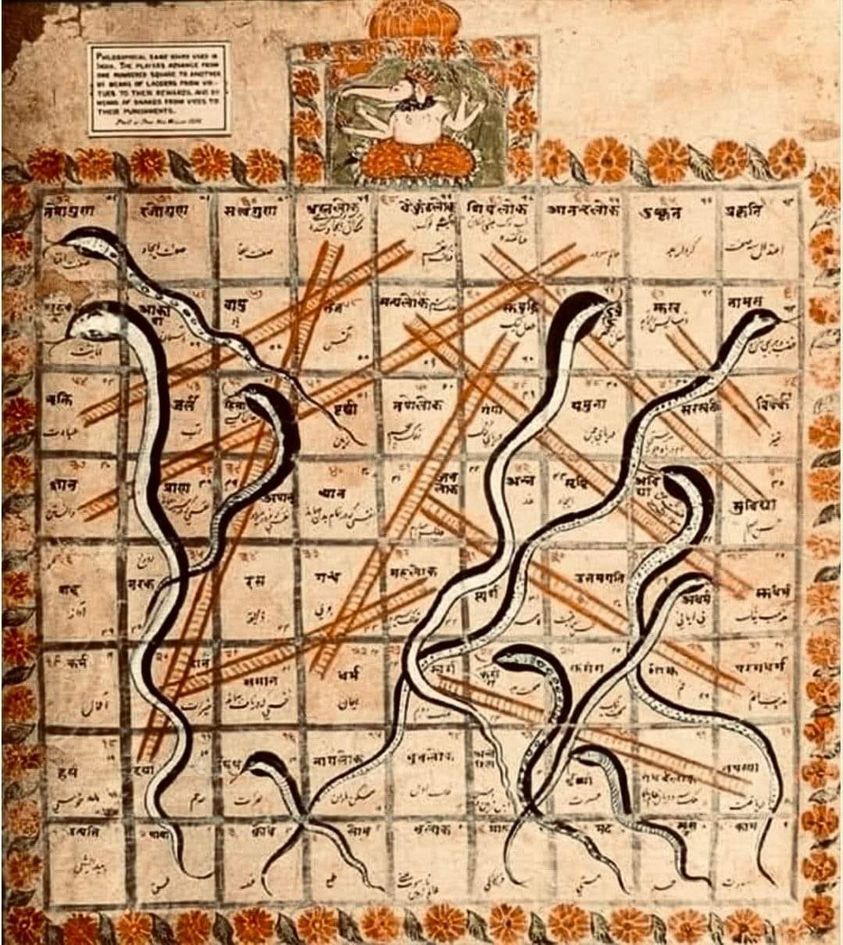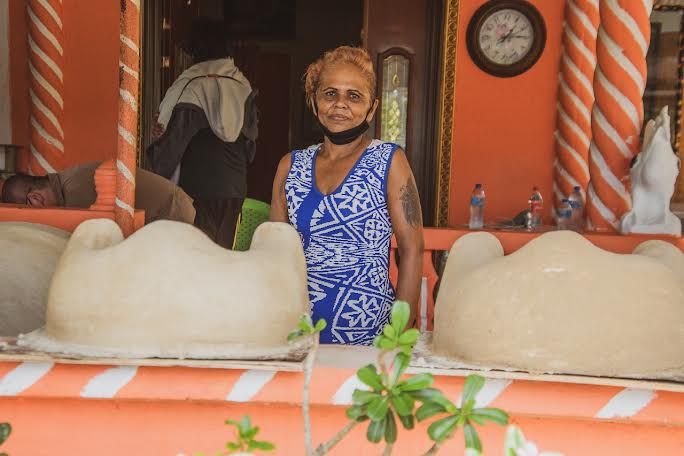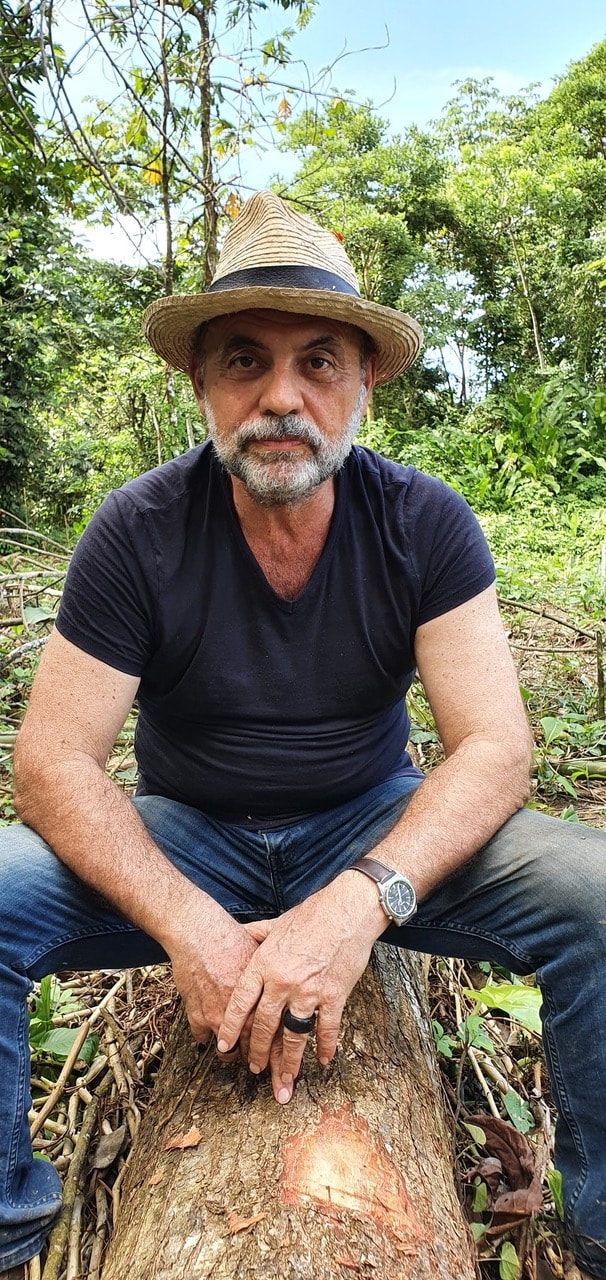 Trinidad-born British actress Jacqui Chan is caught turning the heads of uniformed passers-by in this impromptu photo taken in Venice in 1956 by Antony Armstrong-Jones (later Lord Snowdon), the British socialite photographer who eventually married Queen Elizabeth II's sister. Chan was also a photographic model and, at the time, was Armstrong-Jones's girlfriend. She is thought to have been his first love. Chan had met him in March of 1955, when the 25-year-old photographer took the then-18-year old dancer’s portrait, when she was starring in the play 'Teahouse of the August Moon'. Armstrong-Jones, however, went on to marry Britain’s Princess Margaret in 1960 during the time of his relationship with Chan. When Chan heard the news of her former lover's engagement to the Princess, she reportedly said, "Well, I hope she can cope better than I could." In an interview with The Australian Women's Weekly in February 1961, Chan wanted to make it clear that she had her own success apart from her relationship with Armstrong-Jones. “I do not owe my career to all that sort of publicity," she said. "The suggestion that I had never been offered a job until all this business is what makes me so mad. It just isn't true." Indeed, Chan has had a long and varied career, both as a dancer on stage and an actress on the silver screen. She rose to fame thanks to her turn as Gwennie Lee in a 1959 West End stage production of 'The World of Suzie Wong'. During the 1960s, she had roles in several television series including 'Dixon of Dock Green', 'The Hidden Truth', 'Armchair Theatre', and 'Ghost Squad'. She played the handmaiden Lotus in the 1963 film 'Cleopatra' that starred Elizabeth Taylor. Some of her notable works include the role of Mrs Liu in "Moving Parts" (2017); 'Sherlock' (2012); Mutant Chronicles (2008); Wake of Death (2004); and Netflix drama 'Marco Polo'. Born in 1939, Chan, cousin of famed Trinidadian painter Carlisle Chan, continues to fetch TV and film roles, and has been visiting Trinidad over the years. (Source: Dominic Kalipersad, may 19, 2022)
0 Comments
CAGIS Virtual is a new program that brings STEM into your home with weekly, hands-on, live sessions led by real experts!
CAGIS Virtual events explore a new topic each week with fun virtual and hands-on activities led by real experts and a CAGIS instructor. Each session includes an introduction to the topic, a hands-on or virtual activity, and time for questions at the end. Sessions occur on Saturdays at the following times: Ages 7-12: 8 am Pacific • 9 am Mountain • 10 am Central • 11 am Eastern • 12 pm Atlantic Ages 11-16: 10 am Pacific • 11 am Mountain • 12 pm Central • 1 pm Eastern • 2 pm Atlantic To become a member, Join Now. CAGIS Virtual sessions are open to non-members for $16 per session. Registration will be open to members before the general public. Did you know you can purchase tickets to CAGIS Virtual sessions as a gift? Available here. Schedule Upcoming events will be posted at least one month in advance. Members will have access to event sign up links before the general public. We expect to always have enough space for all sign ups. However, in the event of a very popular event, spaces will go on a first-come-first-served basis with others added to a waiting list. The schedule is subject to change, pending changes in host availability. For more information: https://girlsinscience.ca/join/ THE Observer newspaper of the UK said on Sunday that a British publisher, Penguin, has finally published Capitalism and Slavery written by Trinidad and Tobago's first prime minister, the late Dr Eric Williams.
An article by journalist Donna Ferguson was headlined, “Eighty years late: groundbreaking work on slave economy is finally published in UK. Seminal work by scholar and future politician Eric Williams, shunned for decades, is issued by mainstream imprint.” The work was, so far, published only by the University of North Carolina (UNC) Press in 1944, with a third edition last April. Penguin said its edition will be available from February 22. It said, "Williams traces the rise and fall of the Atlantic slave trade through the eighteenth and nineteenth centuries to show how it laid the foundations of the Industrial Revolution, and how racism arose as a means of rationalising an economic decision. "Most significantly, he showed how slavery was only abolished when it ceased to become financially viable, exploding the myth of emancipation as a mark of Britain's moral progress." Ferguson said, "In 1938, a brilliant young black scholar at Oxford University wrote a thesis on the economic history of British empire and challenged a claim about slavery that had been defining Britain’s role in the world for more than a century. "But when Eric Williams, who would later become the first prime minister of TT, sought to publish his mind-blowing thesis on capitalism and slavery in Britain, he was shunned by publishers and accused of undermining the humanitarian motivation for Britain’s Slavery Abolition Act. "Now, 84 years after his work was rejected in the UK, and 78 years after it was first published in America, where it became a highly influential anti-colonial text, Williams’s book, Capitalism and Slavery, will finally be published in Britain by a mainstream British publisher." She quoted writer Sathnam Sanghera saying, “I think it’s amazing he hasn’t been published until now, because you can’t really make sense of Britain’s involvement in transatlantic slavery without reading his book. It’s so important.” The article said Williams had argued that British slavery was abolished owing to British economic self-interest, not British conscience. Ferguson said Williams said the Industrial Revolution could not have happened without slavery. "In great detail, he lays out the scale of the wealth and industry that was created in Britain, not just from the slave plantations and in the sugar refineries and cotton mills, but by building and insuring slave ships, manufacturing goods transported to the colonies – including guns, manacles, chains and padlocks – and then banking and reinvesting the profits. "It was all this wealth created by slavery in the 17th and 18th centuries that powered the Industrial Revolution in the 19th century, Williams argued." She cited Williams as saying, “A racial twist has been given to what is basically an economic phenomenon. Slavery was not born of racism; Rather, racism was the consequence of slavery.” Ferguson said Williams was rejected by even the 1930s most radical publisher Frederic Warburg, publisher of Adolf Hitler’s Mein Kampf and George Orwell’s 1984 and Animal Farm. Warburg's rejection of the book was because it contradicted the British narrative that abolition was due to humanitarian, not economic reasons, Ferguson said. She cited Prof Kehinde Andrews of Birmingham City University as complaining that many British academics today disbelieve the Industrial Revolution was dependent on slavery and so dismiss Williams's book. “It is good that the book’s being published by a major publisher, but it’s kind of an indictment that it has taken more than 80 years,” said Andrews. “I hope people read it, and it’s nice it’s available. But I think it will probably just get ignored in Britain, the way it has been, largely, in the past.” (Source: TT Newday, January 24, 2022)  THE HISTORY AND LEGEND OF THE POINSETTIA: The plant we know today as the poinsettia has long and interesting history. Native to Central America, the plant flourished in an area of Southern Mexico known as Taxco del Alarcon. The Aztecs used the plant decorative purposes but also put the plant to practical use. They extracted a purplish dye for use in textiles and cosmetics from the plant’s bracts. The milky white sap, today called latex, was made into a preparation to treat fevers. The poinsettia may have remained a regional plant for many years to come had it not been for the efforts of Joel Roberts Poinsett (1779-1851). The son of a French physician, Poinsett was appointed as the first United States Ambassador to Mexico (1825-1829) by President Madison. Poinsett had attended medical school himself, but his real love in the scientific field was botany. (Mr. Poinsett later founded the institution which we know today as the Smithsonian Institution). Poinsett maintained his own hothouses on his Greenville, South Carolina plantations, and while visiting the Taxco area in 1828, he became enchanted by the brilliant red blooms he saw there. He immediately sent some of the plants back to South Carolina, where he began propagating the plants and sending them to friends and botanical gardens. Among the recipients of Poinsett's work was John Bartram of Philadelphia, who in turn gave the plant over to another friend, Robert Buist, a Pennsylvania nurseryman. Mr. Buist is thought to be the first person to have sold the plant under its botanical name, Euphorbia pulcherrima. It is thought to have become known by its more popular name of poinsettia around 1836, the origin of the name recognizing the man who first brought the plant to the United States. Congress honored Joel Poinsett by declaring December 12th as National Poinsettia Day which commemorates the date of his death in 1851. The day was meant to honor Poinsett and encourage people to enjoy the beauty of the popular holiday plant. A charming story is told of Pepita, a poor Mexican girl who had no gift to present the Christ Child at Christmas Eve Services. As Pepita walked slowly to the chapel with her cousin Pedro, her heart was filled with sadness rather than joy. I am sure, Pepita, that even the most humble gift, if given in love, will be acceptable in His eyes," said Pedro consolingly. Not knowing what else to do, Pepita knelt by the roadside and gathered a handful of common weeds, fashioning them into a small bouquet. Looking at the scraggly bunch of weeds, she felt more saddened and embarrassed than ever by the humbleness of her offering. She fought back a tear as she entered the small village chapel. As she approached the altar, she remembered Pedro's kind words: "Even the most humble gift, if given in love, will be acceptable in His eyes." She felt her spirit lift as she knelt to lay the bouquet at the foot of the nativity scene. Suddenly, the bouquet of weeds burst into blooms of brilliant red, and all who saw them were certain that they had witnessed a Christmas miracle right before their eyes. From that day on, the bright red flowers were known as the Flores de Noche Buena, or Flowers of the Holy Night, for they bloomed each year during the Christmas season and thus, the legend of the poinsettia was born. The 13th century poet saint Gyandev created a children's game called Moksha Patam. The British later named it Snakes and Ladders & diluted the entire knowledge - instead of the original Moksha Patam.
In the original one hundred square game board, the 12th square was faith, the 51st square was reliability, the 57th square was generosity, the 76th square was knowledge, and the 78th square was asceticism. These were the squares where the ladders were found and one could move ahead faster. The 41st square was for disobedience, the 44th square for arrogance, the 49th square for vulgarity, the 52nd square for theft, the 58th square for lying, the 62nd square for drunkenness, the 69th square for debt, the 84th square for anger, the 92nd square for greed, the 95th square for pride, the 73rd square for murder and the 99th square for lust. These were the squares where the snake waited with its mouth open. The 100th square represented Nirvana or Moksha.The tops of each ladder depict a God, or one of the various heavens (kailasa, vaikuntha, brahmaloka) and so on. As the game progressed various actions were supposed to take you up and down the board as in life... Though we had played this game during our childhood, like myself, many of us may not be knowing about the very important lessons of life which can be learnt by the children while playing this game. Britishers had destroyed not only Sanskrit but also Hindu beliefs in many ways. After capturing power, the main agenda of the British was looting India of its wealth and spreading Christianity throughout the country by destroying Hindu beliefs and customs. (Source: Virtual Museum of T&T Octob 8, 2021) Phoolwanti 'Doll' Ramsingh, 58, of Doll's Chulhas in Branch Road, Fyzabad, is affectionately known as Aunty Doll, the Chulha Lady from Fyzabad and the Original Chatak Matak Queen.
People come from all over T&T and overseas to her place for the unique culinary and cultural experience from seeing a chulha or dirt oven built from scratch, custom made to the buyer's specifications, to feasting on a variety of delicious food off the chulha–to bread and pizza from the dirt oven 'hot on d' spot,' and spending the day reliving the 'ole time' days. The chulha means different things to different people. It is a link to the past, and can still be found in several people's backyards for sentimental, cultural and traditional reasons hearkening back to the time of their grandparents or great-grandparents. People swear there is no comparison between food cooked on a chulha to food cooked on modern gas and electric stoves, and induction cookers. The chulha can also be used as an emergency stove for when the electricity goes, natural disasters like storms and floods, or when you run out of cooking gas. As people did more cooking and baking at home during the COVID-19 lockdowns, the humble chulha and dirt oven have also enjoyed a resurgence. For Ramsingh, disconsolate over the death of her husband, making chulhas was a way to keep herself occupied and focused and has enabled the mother of seven, grandmother of six and her family to earn a living during the challenging COVID-19 economic times. Speaking to the Sunday Guardian on Wednesday Ramsingh said "October 11 will make it five years my husband Chandersingh Ramsingh died. When I lost him, I used to be like not here. "I dropped everything, I was a wreck. One day I decided to start back and threw myself into my work. When I started back making fireside, I would be enjoying myself and forget all my worries. "When I made the fireside so nice, it made me live. I told my daughter Sandy if not for the chulha I might have gone." She said when she was in the process of making a chulha, she felt so happy inside that she lost track of time and her daughter had to remind her to take a break and eat. Ramsingh learned the art of chulha making from her grandmother Sancherie Dookie from Spring Trace, Fyzabad. She reminisced about when she was a little girl sitting down and watching her grandmother fashioning a chulha, she tried it and it came out just like hers. With the help of family members, such as her daughter Sandy, her grandchildren, among them Abby, who also cooks, Ramsingh can make ten chulhas a day starting from around 10 am to 10 pm. A dirt oven will take a week to frame with steel and BRC wire. She also fits in brush cutting with a weedwhacker six days a week from Monday to Saturday with her son Randy in the morning, and when she returns home, she starts work on her chulha making. Ramsingh revealed that the reason they started selling 'chulha food' was that a lot of people did not know the taste of it, so she and her daughter decided to cook and cater food from the chulha and dirt oven. The menu includes on dirt oven Thursdays: coconut bake and baked chicken. Chulha Fridays: stew-curried chicken, channa and aloo, murtani, dhalpuri and mother-in-law. Chulha Saturdays: curried duck, channa and aloo, murtani, buss up shot and mother-in-law, to pepper roti, octopus, and bread and pizza from the dirt oven are also available. She and her daughter Sandy were trying out new dishes such as pumpkin with chicken, sweet pepper and carrots in the dirt oven. Tuesday night they did channa puri stew/curry chicken and chataigne puri. Ramsingh said that people from all parts of Trinidad, even Tobago come to her house to sample her 'sweet hand' and buy a chulha or dirt oven. They come from as far as Tunapuna, Mayaro, Aranguez, Trinicity, Cunupia, Siparia, Fyzabad, Princes Town, Penal, Debe, Avocat, Santa flora. Trinidadians living in the diaspora in the US, Canada, and Europe have also visited. You can see Ramsingh on Facebook @ Doll's Chulhas and Fireside Cooking With Doll-Hot From The Chulha. My name is Piero Guerrini and, 28 years ago, I came to Trinidad for ten days. I’m still here.
I come from Grande Riviere but I was born in Italy. My father used to be a coal miner in Belgium and he would talk about how wonderful it was for him, as a young man, to go from Italy to a different country. My father used to go 1,000 metres below ground level to literally pickaxe coal out of the rock. He was paid by the amount of coal he was able fetch out of the mine every day. But he always passed me this idea of travelling. Since I’m 18, 19 years old, I’m saying, “Daddy, I’m not going to live in Italy. I want to travel.” Finally, my father said to me, “Okay, I would like you to be close to me but you go ahead.” Since 20, I’ve been travelling. I became a photographer, because it combined my lifestyle and my desire very well. I travelled so much. Until I reached Trinidad and Trinidad chose me. From the first day, it was love at first sight. I’m vegetarian. I’m against industrial food. My life has been divided into three parts. I was a photographer and then I was a hotelier on the beach. Not many people know the first part: I was a professional footballer. I used to play No. 10. Of course. Long hair. Everybody said Piero is going to be a great footballer. I had big promise in Italian football. I tried for Juventus, Bologna. I got a back injury when I was 19 and start to have problem. My only child, Aurora, 23, started doing a masters degree on a scholarship at Oxford and her professor said, “You can skip the masters and go straight for the PhD.” I’m very proud of her achievement. She is the president of the Conservative Students Association. I don’t know, maybe she rebelled [against me] by becoming a conservative. She tells her friends her dad is a hippie. I lost my father two years ago and, to be honest, I was losing my way. I was single, frustrated, working all the time. I wasn’t happy. I wasn’t sleeping well. I had gained some weight. And then, in two wonderful months with my mother, she told me all the things she hadn’t before. How my parents met, what they did together. When I came back, I start to think, “I need not to be alone anymore.” And then I met Sali. The lockdown gave us the possibility to really get to know one another. She is my “one”. You have to go back to who you are, the person you really are. You have to not be afraid to [allow] yourself [to come] out. I lost 20 lbs. Now I am the Piero I know I wanted to be. Now I sleep well. I met [Trinidadian/St Lucian poet] Derek Walcott in Boston during the Nobel Prize tribute celebration as well as [late musician] Andre Tanker, actor Albert Laveau, Glenda Thomas [now Collens see Trini to D Bone 19 April 2021]. Derek said, “You wouldn’t believe the talent that is in Trinidad!” Glenda came in and start to sing. He said, “And she’s unknown in Trinidad!” Every year, as a photographer, I did a series called, “The World of” [that year’s Nobel Literature Prizewinner] and so I came to Trinidad to photograph Derek. The year before, I’d gone to South Africa, when Nadine Gordimer had won the prize. Back then, the “BeeWee pass” [let you] go in all the BeeWee destinations for US$300. So I went in 14 different islands. But Trinidad was, immediately, immediately, the place I was looking for. I had a part in Damian Marcano’s short film, Cheese, but I don’t know anything about music or movies after the 90s. When I go to show her a film, Sali always asks, “And how old is this one?” At Maria Regina Prep School, there was every possible race and class of child. Brian Lara daughter was in class with my daughter. In another country, a person like Brian Lara would have fans [smothering him]. Here, he’s just like a normal person. And there were kids of security guards, working class people, whatever. I always tell Aurora she should be thankful to grow up in such a wonderful environment. I used to say, Trinidad is my India AND my Africa. You don’t need to travel far away because EVERYTHING is in Trinidad. After arriving, I didn’t go anywhere for four years. I was in the Trini lifestyle. [During] my trip to Trinidad, the Mt Plaisir Hotel property became available. When the owner saw the white man, she doubled the price but she accepted my counter-offer and we opened up that December. We only had three rooms at first. One of my staff was a Spiritual Baptist and she went on a fast. I asked her to ask if Mt Plaisir would be successful. When she came back, she said it would be so successful you won’t believe it. And it was true. Everything has been beyond my expectations. The success almost trapped me in the business. I don’t think I will continue with the same intensity without Aurora but it has been a fascinating journey. There were a lot of setbacks for Mt Plaisir. The beach was almost completely washed away, and the hotel. Two qualities, patience & resilience, were missing in my personality. I’m very happy Trinidad taught me patience. I used to be very stubborn. [Trinidad has turned] that stubbornness into resilience. The people of Grande Riviere, they adopt me, they accept me, they help me, they support me. They still do. It’s amazing. They say home is where you feel loved and protected and that for me is Grande Riviere. I sleep with door and window open, even in these days. I talk to all the so-called bad boys., all the boys I used to give one day of work on Saturday morning, to collect the leaves on the beach. All these years, I haven’t changed my relationship with them. My story with turtle: I arrived in Grande Riviere in August and there were no turtle and I thought people telling me about these huge turtle coming to the beach were exaggerating about their size and number. The first time I saw a turtle was on my birthday, 27 February 1994, with my father, and I was astonished by the size! I lay down on the sand to compare my size and she was bigger than me. When I came, the beach had 2-4K turtle per season. I encouraged the people of the village to protect the turtles and they really got organised on the right track. After 27 years, Grande Riviere, with 30-40K nesting per year, is now considered the leading place in the world to watch leatherback. I had so much expectation of the new post-Covid world. I thought our government would see some new light but, no, they are blind and continue to go down the same road. I made a proposal to [government advisory] committee. They said thank you. A UNESCO Heritage Site [status] for the beach would bring more exposure and financing. But, unfortunately, the government is focussed on different things. My big [personal] change came when I was 27. A psychologist friend in Italy and I, we used to go walking around and talking in the night and, one night, he decide to go deep on me and really put me through some psychoanalysis tests. He made me cry because I discovered certain things but, from that day, I took control of my life. I decide to become a photographer. I became much more stubborn Life always is full of surprises. I love Carnival and my desire is to photograph it in a way that hasn’t been done before. I was getting into Carnival when Peter [Minshall] was active. He was the only one who captured my desire to free myself. I did M2K and Lost Tribe. I don’t take part any more. It doesn’t grab my gut. The soul of Carnival has been lost somehow. [Younger people today] don’t know what we used to have in Carnival. Before Covid, I would walk in Port of Spain, just to look at the people. You see this beautiful face, this incredible combination of every possible race. Chinese/black, Indian/white, any kind of whatever. I still love it. Even though everybody’s masked up now. That beautiful energy of the country is still there. Now you have to be attentive, if someone is following you for some reason. Maybe this paranoia about crime, all these things have their consequences on our psyche. [After] Covid, I see people being very unkind. Not the Trinidad that I know. In 2001, when he won the Nobel Literature Prize, VS Naipaul wanted photographs for new editions of his books. He spent two days with me in Grande Riviere and he was amazing! Absolutely wonderful! I’m probably one of the few people in the world who have this sweet idea of VS Naipaul. He was so curious about my life, asked me so many questions, I thought he might have been doing research for some book or something. He used to hold my hand to go and see turtle. I did the cover of Guerrillas, A House for Mr Biswas and The Night Watchman’s Occurrence Book. He invite me to his house to photograph him. Instead of me going to look for people, people started coming to my little universe, artists, interesting people coming to stay. Sir David Attenborough has been several times. Peter Doig became famous through the work he did in Grande Riviere. Chris Ofili. Margaret Atwood, a birdwatcher, came for the birds. Grande Riviere still remains that source of inspiration for so many people. I turned the clock 25 years back. I have that same energy. Even the guy working with me [building a house by hand from foundation up], he is 35, 40, and he gets tired right away. I dig my foundation, there are stones in the ground and you have to dig and dig and dig. I’m very happy I still have this romantic idea about Trinidad. All the barbarian attitude of the society has not affected me yet. [Late poet & newspaper writer] Wayne Brown described the Trinidadian as “the people who laugh.” My friend from Miami asked, “Why people laugh so much here?” I say, “That’s how they are.” And, in Conde Nast Traveller magazine, a writer said, in Trinidad, you see people in the morning, happy to be listening to the birds. [For me, then] a Trini is a person who laughs and is happy just to be alive. In the ten years before I came to Trinidad I went to, I think, 65 countries. In Hong Kong, in Kenya, other places I was considering to stay a long time. To me, Trinidad & Tobago was the one place that I felt at home for the first time. Trinidad is home. Source: Trini to d bone, July 17, 2021 |
T&T news blogThe intent of this blog is to bring some news from home and other fun items. If you enjoy what you read, please leave us a comment.. Archives
June 2025
Categories
All
|







 RSS Feed
RSS Feed